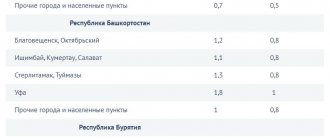Every motorist is required by law to buy compulsory motor liability insurance, but payments under a compulsory insurance policy are not always enough to compensate for damage caused to victims - third parties. And in this case, the culprit of the accident must compensate part of the amount himself. Voluntary motor liability insurance allows you to protect yourself from such costs. For motorists who want to minimize their financial risks in the event of an accident, AlfaStrakhovanie offers an additional insurance product - extended compulsory motor liability insurance. You can buy such a policy together with CASCO.
Why do you need extended MTPL
The CASCO policy only covers the damage that was caused to your car. This insurance program does not affect your liability to the second party injured in the accident. At the same time, the maximum damage that an insurance company can compensate under an MTPL policy is regulated by law, and at the moment (April 2021) its amount is 400 thousand rubles. In contrast, the payment under an extended compulsory motor liability insurance policy is limited only by the limit of the sum insured, which you can choose yourself. We offer two coverage options under this auto insurance program – 1 million rubles and 1.5 million rubles.
What to do if the payment is not enough
It is no secret that in practice insurers underestimate the amount of payment in order to reduce costs. You need to know that according to the law, every victim has the right to receive full payment, within the limit.
What to do if the payment is not enough to carry out repairs:
| Contact an independent expert | The first thing you need to do is contact an independent expert who will inspect the car and indicate the real amount of damage caused. In addition to the official conclusion, you must take a receipt confirming payment for services. |
| Get a certificate from the bank | Since insurers transfer funds to the victim’s card, you will have to contact the bank and get a statement. The document must reflect: · date of payment; · amount; · the organization that transferred the funds. In practice, banks issue statements completely free of charge, immediately on the day of application. |
| Make a pre-trial claim | You can file a claim yourself or seek help from an expert on our portal. |
| Wait for an answer | Within 5 business days, the insurance company must provide a formal response or make a payment. |
In practice, insurance companies are reluctant to pay out money upon a client's request. This occurs only in large companies that value not only their reputation, but also each client.
What to do immediately after an accident
The correctness of the first actions after an accident, if the culprit fled the scene, is of great importance so that in the future you can count on compensation for the damage received. If there is such an opportunity, you need to remember the signs of the car, which will allow you to identify the culprit. The main such signs include:
- car make and model;
- body color;
- state number of the culprit's vehicle;
- the nature and location of the damage received by the culprit’s vehicle;
- other characteristic features.
What you should never do is chase the person responsible for the accident. In this case, you will also be considered a participant in the accident who fled the scene. This means that you will no longer be able to count on payment. Moreover, you will have to deal with serious consequences, including criminal liability.
Therefore, first of all, you need to calm down and carry out the list of standard actions for registering an accident, but with some features, taking into account the situation.
Registration of an accident
First of all, as with any accident, you need to turn on the hazard warning lights and put up a warning triangle. If there are injuries as a result of the accident, you need to call an ambulance. After this, you need to call the traffic police. During the call, be sure to clarify that the second participant fled the scene.
If you remember any signs of the car that caused the accident, they should also be reported to the operator. If you have a DVR installed in your car, then before calling the traffic police you need to view its recording. It is quite possible that the device will record the license plate number and other important signs that you can transfer to the inspection by phone.
By informing traffic police officers of the characteristics of the vehicle responsible for the accident over the phone immediately after the accident, you significantly increase your chances of successfully resolving a difficult situation. In many such cases, this allows the inspectorate to intercept the culprit “hot on its heels,” which will significantly simplify the process of obtaining compensation.
Please note that if there are no injuries as a result of an accident, and the damage is only to your car, then you should not expect special zeal from law enforcement agencies in finding the culprit. Therefore, it is extremely important to be active yourself, including in collecting signs and possible evidence.
After calling the traffic police, try to immediately find witnesses to the incident. If they cannot wait for the inspectors to arrive, ask for their contact information. It is also recommended to inspect the area around the scene of the incident for the presence of CCTV cameras that would help identify and find the fugitive culprit.
It would be a good idea to take photos or videos of all the damage to your car and the circumstances of the incident. Along with the resulting defects, you need to record the license plates of your car in the frame. Try to include objects in the frame that allow you to make a reference to the area (recognizable buildings or structures, address signs, signs, etc.). The date and time of the shooting must be displayed in the frame.
After the arrival of traffic police inspectors, the following actions must be taken:
- describe in detail to the inspectors the circumstances of the incident;
- indicate that the person responsible for the accident fled the scene;
- provide all the information you have about the culprit;
- provide inspectors with witnesses to the incident or provide their contact information;
- if possible, indicate the presence of nearby CCTV cameras that could have recorded the accident;
- make sure that all this information is reflected in the protocol, check that it is filled out correctly and sign it.
In addition, it is recommended to call your insurance company and report the occurrence of an insured event. In this case, you should definitely clarify that the accident was not your fault, and the culprit fled the scene.
After completing a report at the scene of the incident, you will need to go to the nearest traffic police department. Here you will need to write a statement about searching for an escaped participant in an accident. Also, do not forget to get a certificate of the accident and a copy of the protocol.
Filing a claim due to underestimated compensation for damages under compulsory motor liability insurance
We showed above that if insurers underestimate the amount of payment, a claim letter should be drawn up. There are no approved requirements for drawing up this document, so the victim has the right to make a claim in free form.
Both computer-printed and handwritten documents are acceptable. Mandatory elements are the applicant's signature and the date of signing. In addition, the document must reflect the following information:
| Name and contact details of the insurance company | The claim header contains: ·Company name; ·its legal address; ·Full name of the head; ·work phone number and email address. |
| Personal details of the applicant | The document header also displays: · Full name of the applicant; · his passport details; registration address; ·Mobile phone number. |
| The essence of the appeal | The main information block where you need to clearly indicate: date and time of occurrence of the insured event; · payment case number; actual amount paid; · the actual amount due if you have a compulsory motor liability insurance policy to compensate for damage in the event of an accident to the victim. |
| Applicant details | Full bank details must be provided to transfer the additional payment. |
| Attachment of copies of documents | In addition to the claim itself, it is necessary to prepare copies of the following documents: ·passport; · opinion of an independent expert. The victim should keep the originals with him if it comes to lawsuits for damages under compulsory motor liability insurance. |
The insurance company may be declared bankrupt. In such a situation, the pre-trial claim must be sent to the Russian Union of Auto Insurers (RUA) by registered mail or the document must be taken personally to the organization’s office.
The victim can send a letter of claim within three years from the date of receipt of the insurance payment. The insurer's obligation to review the amount of compensation and actually pay the difference is valid during this period. After the statute of limitations has expired, the insurance company has the legal right to refuse to consider this document.
Tariffs and payments under the DSAGO policy
Tariffs for registration of DSAGO are set taking into account several parameters. Among other things, the price will depend on the maximum liability limit of the policy. The greater the amount of damage covered by insurance, the higher the cost of the insurance product.
Payments for compensation of damage under the extended insurance policy are made minus the coverage under the standard OSAGO policy. Let's consider a case where a car owner purchased a DSAGO with a limit of 1 million rubles. If in an accident due to the fault of the policyholder, damage to another vehicle in the amount of 1 million rubles is caused, payments are made as follows. According to standard compulsory motor liability insurance, 400 thousand rubles are compensated. The remaining amount will constitute compensation under the extended liability insurance policy. In the example under consideration, this is 600 thousand rubles.
You can buy DSAGO from any official representative of AlfaStrakhovanie at the same time as purchasing a CASCO policy. For more information about the cost of insurance, please contact our consultant.
What is better to choose: repairs or money
Since if you have a compulsory motor liability insurance policy, compensation for damage is possible in two options, you should identify the most profitable one. To do this, consider the pros and cons of each compensation method.
| Refund Option | Advantages | Flaws |
| Car repair | The car owner does not need to independently select a service station suitable for repairs. | There is a risk of sending the car to an unofficial dealer or to a station located at a considerable distance. |
| Financial compensation | By managing the money, the car owner can independently repair minor damage and thereby save on professional repairs. | The money paid may not be enough for a complete repair. The victim will have to pay extra from his own funds. |
Thus, each car owner determines the profitable option for himself. However, according to statistics, owners of new cars more often choose compensation in the form of repairs at a service station. The benefit here is that it is possible to have the car repaired by an authorized dealer while maintaining the warranty.
If the driver involved in an accident or his friends own their own service station, where repairs can be performed at minimal prices, the most profitable compensation option will be payment in cash. The money paid is usually spent exclusively on spare parts.
How victims received insurance payments before
During the first 6 years of the MTPL system in Russia (since 2003), victims were ordered to apply for payments to the insurance company (IC) of the person responsible for the insured event.
In theory, there should have been no problems here, but they began to arise due to the large difference between insurers - some diligently fulfilled their obligations, others did not.
And if the culprit was insured in a dubious establishment (and at that time there were many of them), then the victim began to have problems with payments because of this, which he could do little to influence. The victim’s own insurer just shrugged his shoulders.
Introduction of an alternative direct insurance compensation procedure
After understanding the current situation, in 2009, the authorities decided to give policyholders the opportunity to choose an insurer to receive compensation.
The victim could choose:
- The classic option is with payment from the culprit’s insurance company;
- An alternative option is direct payment from your own insurance company (PVU).
The idea was good and initially brought some positive results, but not for long. Irresponsible companies quickly got their bearings and realized that they had got their hands on a legal tool for “footballing” victims to their colleagues.
And if a person applied for payment to the insurer of his choice, then, under various pretexts, they convinced the victim of his “wrong” choice and “reasonably” pointed to the second company associated with this case. The new rules allowed this.
This is what the insurers of both the perpetrators and the victims did, often repeatedly sending the applicant for compensation to each other. The economic crisis aggravated the situation and even decent insurance companies began to commit such trickery. And quite a few drivers were caught cheating - they submitted claims for compensation to both insurers at once.
As a result, the government decided to put an end to this absurdity and, 5 years after the first reform, introduced a procedure for non-alternative direct compensation of losses.
Nuances of compensation for damage under compulsory motor liability insurance
- Insurance policy is not in the database
There are situations when a participant in an accident for some reason is not included in the insurance company’s database, even if he purchased the policy legally. In this case, you must provide proof of the actual purchase. Only after this, if you have a compulsory motor liability insurance policy, compensation for damage will be legal.
If compulsory motor third party liability insurance was purchased illegally (for example, for reasons of economy, the car owner bought a fake document at a low price), the insurance company will not recognize this document as valid and will not pay compensation. The only option in this case is legal recovery of funds directly from the culprit of the accident.
- The OSAGO policy contains errors
The car owner fills out the electronic version of the policy independently. The entered data is then checked against available databases. However, mistakes are sometimes made. In former times, one fact of erroneous data was enough to invalidate the policy. Now such a refusal is considered illegal based on a decision of the Supreme Court.
Even a mistake made by the car owner should not be a reason to invalidate the policy or refuse compensation for damages under compulsory motor liability insurance. There are two ways to solve this problem. It all depends on the time when an error was detected when entering driver data.
If this happened before the insured event, the car owner will have to pay extra for the policy. In the event of an accident, damages are compensated in the usual manner.
If the error is discovered after the insured event has already occurred, insurers will still pay compensation, but in the format of a regressive claim. That is, compensation for damages under compulsory motor liability insurance will be carried out from the culprit of the accident.
In other words, payment of compensation will follow in any case, regardless of the relationship between the culprit of the accident and his insurance company. For the driver at fault in an accident, there are two options: a refund of the entire amount for the damage caused, an additional payment up to the amount of compensation (accordingly, the insurers will pay the amount).
Therefore, it is advisable for each owner of a compulsory motor liability insurance policy to double-check their data if issued via the Internet. If an error is discovered, you should inform the insurers about it and honestly pay the difference. Otherwise, if an insured event suddenly arises, a regressive claim may be applied, which means that you will have to overpay.
Remember that they can refuse if the culprit of the accident does not have a compulsory motor liability insurance policy, but if the victim does not have compulsory motor liability insurance, and the culprit has civil liability insurance, then the victim can simply contact the culprit’s insurance company, but if he has a policy, he is obliged to pay compensation in full volume, even if an error is detected when issuing a policy
- Correction of data in the current policy is prohibited
You cannot change the policyholder or the car in the document. Replacing the owner in MTPL is possible, but only if the policyholder contacts the insurance company, under a contract. Those. in the MTPL contract, only the policyholder can replace everything (except VIN) (there must be a reason for the change). If the new owner approaches the insurance company with a request to replace the owner in the MTPL agreement and he is not the policyholder, the insurance company will refuse him.
Therefore, in the event of a change of owner or vehicle, the only option is to purchase a new policy.
Let's show this with an example. You purchased MTPL for a year, but after six months you decided to sell the car. In this case, you are entitled to a refund of the insurance premium for six months, but the new owner will be forced to buy his own policy.
The situation is similar with updating a car. The old car was sold and a new one was purchased to replace it. The unused insurance premium will be returned to the car owner, who, in turn, issues a separate policy for the purchased car.
If there is a change of owner, then you need to understand that only the policyholder can apply for any changes, and if the client needs to apply for any other changes, for example, add a driver, he will not be able to do this, only the policyholder under the contract. Under compulsory motor liability insurance, the owner applies for compensation for damage. But to terminate the contract, the policyholder is needed.
- A car is sold, bought or rented
If you have valid MTPL insurance, compensation for damage is possible only to the current owner of the car. The renter or driver by proxy is not entitled to such compensation.
Let’s imagine a situation: you got into an accident, after which you sold the car, but did not have time to receive compensation under compulsory motor liability insurance. In this case, the new owner cannot claim compensation, even if he wants to send the car for repairs. In this regard, when buying a used car that has been in an accident, do not trust the seller who promises to transfer you the right to insurance coverage. If the previous owner is considered a victim, he will receive compensation, not you. And you will not prove your right to compensation in any way to the insurance company.
- Loss of marketable value
In accordance with the law on compulsory motor liability insurance, compensation for damage is possible even in the event of loss of the marketable value of the car. Let's give an example. A new car worth 650 thousand rubles was scratched in an accident due to the fault of another driver. In a standard situation, insurers would send the damaged car to a service station, where the car's body would be painted. However, a painted car with replaced components will already cost significantly less than a completely new one. This difference in cost is included in the amount of damage within the maximum possible compensation under the MTPL policy.
- Absence of the culprit of the accident in the policy
Auto liability insurance covers a specific vehicle and a specific owner or several people. All this data must be indicated in the policy. However, if the car is involved in an accident, and the culprit of the accident is not in the OSAGO document, the procedure for compensating the damage to the victim must still be followed.
Let us again illustrate the situation with an example. Let's say there was a collision between two vehicles. The driver of one of them, who was at fault for the accident, is not listed on the insurance policy. Moreover, he doesn't even own the car. Previously, some insurers refused to compensate the victim for damage, and it was necessary to seek compensation through the courts. There is judicial practice of compensation for damages under compulsory motor liability insurance in local authorities.
Later, the Supreme Court clarified that this position is fundamentally incorrect. The insurance company must compensate the victim for damages regardless of whether the person at fault is included in the policy or not. The lack of information about the driver responsible for the accident will be fraught with consequences for himself. Insurers have the right to present him with a regressive claim. But all this should no longer concern the victim; he will receive compensation in any case. This is the case if the culprit is not included in the insurance, but if there is no insurance for this car at all, the insurance company will not compensate. But in case of harm to life and health, the victim can apply to the RSA for compensation.
Useful tips
- An application for payment under a PPV is written only in the name of the insurance company - if you write it in the name of a representative of the insurer, then direct compensation will be denied to you, keep this in mind.
- To find out whether the insurance company has committed gray schemes within the framework of the PES, you need to look at the statistics on the fulfillment of its obligations since the fall of 2014 - fraudulent companies are noticeable by a sharp decrease in the average amount of insurance compensation. You need to look for these statistics in the “Bulletin of the Bank of Russia”, where they must be published annually, in accordance with the provisions of Federal Law No. 40 (Article 8, paragraph 5). There is an online version of the Bulletin on the website of the Central Bank of the Russian Federation.
- Proper preparation of documentation about an accident and an insurance policy with an image will reduce the risk of losing a significant part of compensation to a minimum.
Now you understand the differences between the old and new PES, you know what it means that there is no alternative to the latter, you are familiar with the procedure for its registration and possible pitfalls from insurance companies.
Compensation for damage under the European protocol
For 2021, there are some restrictions on the amount of compensation in accordance with the European protocol. Paragraphs 4 and 5 of Federal Law No. 40-FZ state: it is allowed to independently draw up a document as a result of an accident if the maximum amount of damage is:
- up to 100 thousand rubles;
In this case, the European protocol is drawn up by the participants in the accident on a regular form. If there are disagreements between participants in an accident regarding the circumstances of harm caused in connection with damage to vehicles as a result of an accident, the nature and list of visible damage to vehicles, in order to receive insurance compensation within 100 thousand rubles, data on the accident must be recorded and transferred to the AIS OSAGO in one of the following ways :
- GLONASS;
- mobile app.
- from 100 to 400 thousand rubles.
Here, in order to draw up a European protocol, the participants need to come to a mutual agreement regarding the guilt of one of them in the accident. It is also necessary to register the accident in the accident application. Europrotocol, which is available in the App Store and Google Play. You can download and install the program absolutely free.
Conditions:
- no more than 2 participants in the accident;
- no harm to health or life is caused;
- each participant in an accident has a valid MTPL policy;
- no disagreement.
If it is impossible to install this application, the limit for compensation for property damage under compulsory motor liability insurance will be limited to 100 thousand rubles.
After drawing up a European protocol, the participants in the accident submit the document to the insurers so that they can calculate compensation for damage. It doesn’t matter here whether the driver is the culprit or the victim. This circumstance will be taken into account at the stage of determining how damages will be compensated under compulsory motor liability insurance.
After transferring the notice and other documents to the insurance company employee, you need to receive the following information: full name and position of the employee receiving the documentation, incoming documentation number, case details and registration date. It is advisable to deliver correspondence personally to avoid various undesirable situations. However, delivery by registered mail with return receipt requested is also acceptable.
It should be borne in mind that after submitting all the necessary papers, it will be difficult to demand anything additional from insurers. An exceptional situation is compensation for health damage under compulsory motor liability insurance. In this case, it is allowed to contact the insurance company again with problems that arose after the European protocol was issued.
For 2021, the rule is that both the at-fault party and the victim must submit a signed notice to the insurance company within five business days of the stated date of the accident. Otherwise, insurers have the right to refuse compensation for damage. This is stated in paragraph 2 of Article 11.1 of Federal Law No. 40-FZ. Moreover, in the next 15 days, the driver cannot repair the damaged car on his own until it is inspected by representatives of the insurance company or authorized experts.
Along with the European protocol form, it is necessary to submit a set of documents for compensation for damage under compulsory motor liability insurance, determined by the rules of this insurance company. The standard list of documentation includes:
- application for compensation for losses resulting from an accident, drawn up on an approved form;
- the applicant's passport or other identification document;
- driver's license;
- vehicle registration certificate;
- MTPL agreement, which specifies the driver of the vehicle;
- photo and video materials, as well as other data specified in Article 11.1 of Federal Law No. 40-FZ.
Sometimes the insurance company requires additional documents in accordance with the rules in force in this organization.
In turn, the insurer, in order to determine the cost and scope of repairs, is obliged to conduct an examination of the car at its own expense within five days from the date of submission of the European protocol by the applicant. This is stated in paragraph 10 of Article 12 of Federal Law No. 40-FZ.
The same legislative act (clause 15.1 of Article 12) obliges the replacement of damaged components and parts with new ones that have not been previously used or restored, unless otherwise specified in the insurance policy. The minimum warranty period for work performed is six months. Painting is guaranteed for up to one year.
If the car owner does not agree with the established amount of damage, he can contact independent experts to re-inspect the vehicle.
The insurance company is obliged to offer the car owner a suitable repair shop within a radius of 50 km from the scene of the accident or the victim’s place of residence (clause 15.2 of Article 12 of Federal Law No. 40-FZ). To do this, it is necessary that the insurer has a network of such service stations in a specific area. The car owner can choose a repair shop himself, if this is allowed by the contract. The insurer posts on its official website information about the list of service stations with which it has contracts. The insurer is obliged to provide this information to the victim so that he can choose a service station when applying to the insurer with an application for insurance compensation or direct compensation for losses (clause 17 of Article 12 of Federal Law No. 40-FZ).
These rights and obligations are reflected in clause 15.2 of Article 12 of Federal Law No. 40-FZ. It also states that the car must be accepted for repairs within 20 days after submitting documents about the accident. In this case, the restoration of the vehicle itself should not last longer than 30 calendar days.
Organizations that own vehicles and owners of non-passenger cars also apply for monetary compensation. This is referred to, respectively, in paragraphs 15 and 15.1 of Article 12 of the above federal law.
What does the Civil Code of the Russian Federation say about compensation for losses?
In this case, the limit of insurance payments is set by the policyholder himself. The extended package adds additional services to the mandatory insurance. The cost of an extended policy is higher than that of a standard one. The price is set by the insurance company in each specific case. The extended policy is issued simultaneously with the standard one. Insurance company employees use reference books to determine the value of a car. Electronic and paper.
Nowadays it has become fashionable to launch a model without OTTS on the market. Changan also followed this path: a certificate from Rosstandart for the compact crossover CS55 in the Russian representative office should be received “...
Parties and participants in civil legal relations, of which there are many, must respect the rights of each other and other persons. Violation of rights leads to negative consequences specified by law for the violator. One of them is compensation for losses under the Civil Code of the Russian Federation, which regulates the possibility and procedure for such compensation.
Article 53.1 of the Civil Code on compensation for losses is devoted to them. If there is fault and at the request of the enterprise, the person must compensate for the losses caused.
The amount of earnings (income) lost by the victim to be compensated is determined as a percentage of his average monthly earnings (income) before injury or other damage to health or until he lost his ability to work, corresponding to the degree of loss of professional ability by the victim, and in the absence of professional ability to work - the degree of loss of general ability to work.
Only individuals aged 18 years and older who are not under guardianship, are not engaged in entrepreneurial activities and have a residence/registration address in Russia can place orders. H&M and its distributor reserve the right to limit the delivery of goods to certain regions during certain times of the year.
State social insurance and social security bodies, as well as medical insurance organizations, do not have the right to make recourse claims against the insurer providing compulsory insurance.
Why is issuing a policy at Rosgosstrakh profitable?
In this company, the permissible insurance period is 6-12 months. A convenient program for those who use the vehicle seasonally. The contract can be concluded only for the time that is really necessary.
Additional discounts are possible for clients who have already taken out insurance but have not applied for payments.
The Rosgosstrakh company does not require certificates from the traffic police in case of damage to:
- A standard light fixture. Or body related parts, in an amount of no more than two pieces. This also applies to paintwork.
- One body glazing element, excluding the roof.
The list of parts for repair without presentation of additional documents varies depending on the value of the car and what type of insurance was taken out.
What is CASCO?
Sometimes an unconditional deductible becomes a substitute for coefficients if the driver has little experience when concluding a contract.











